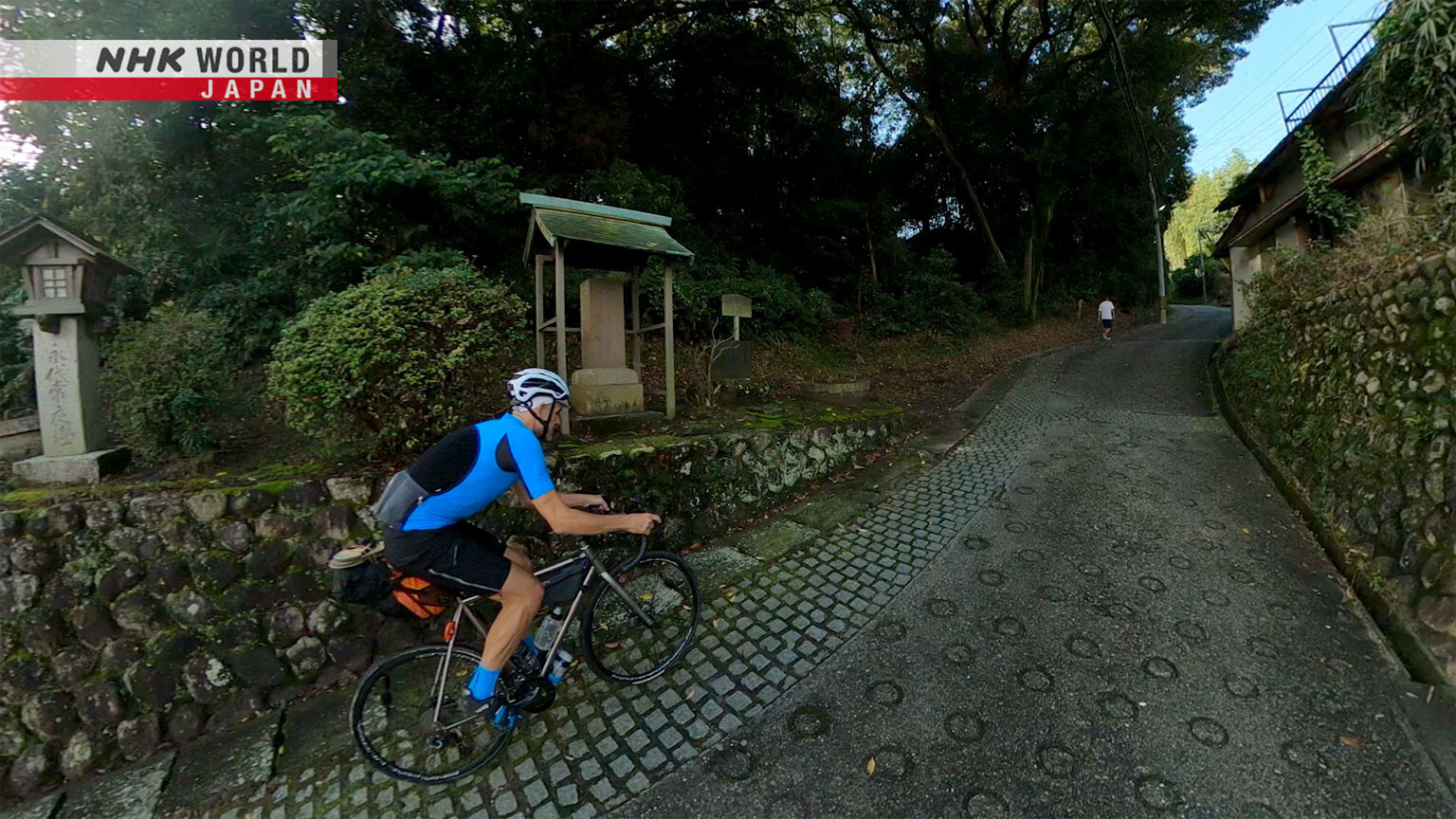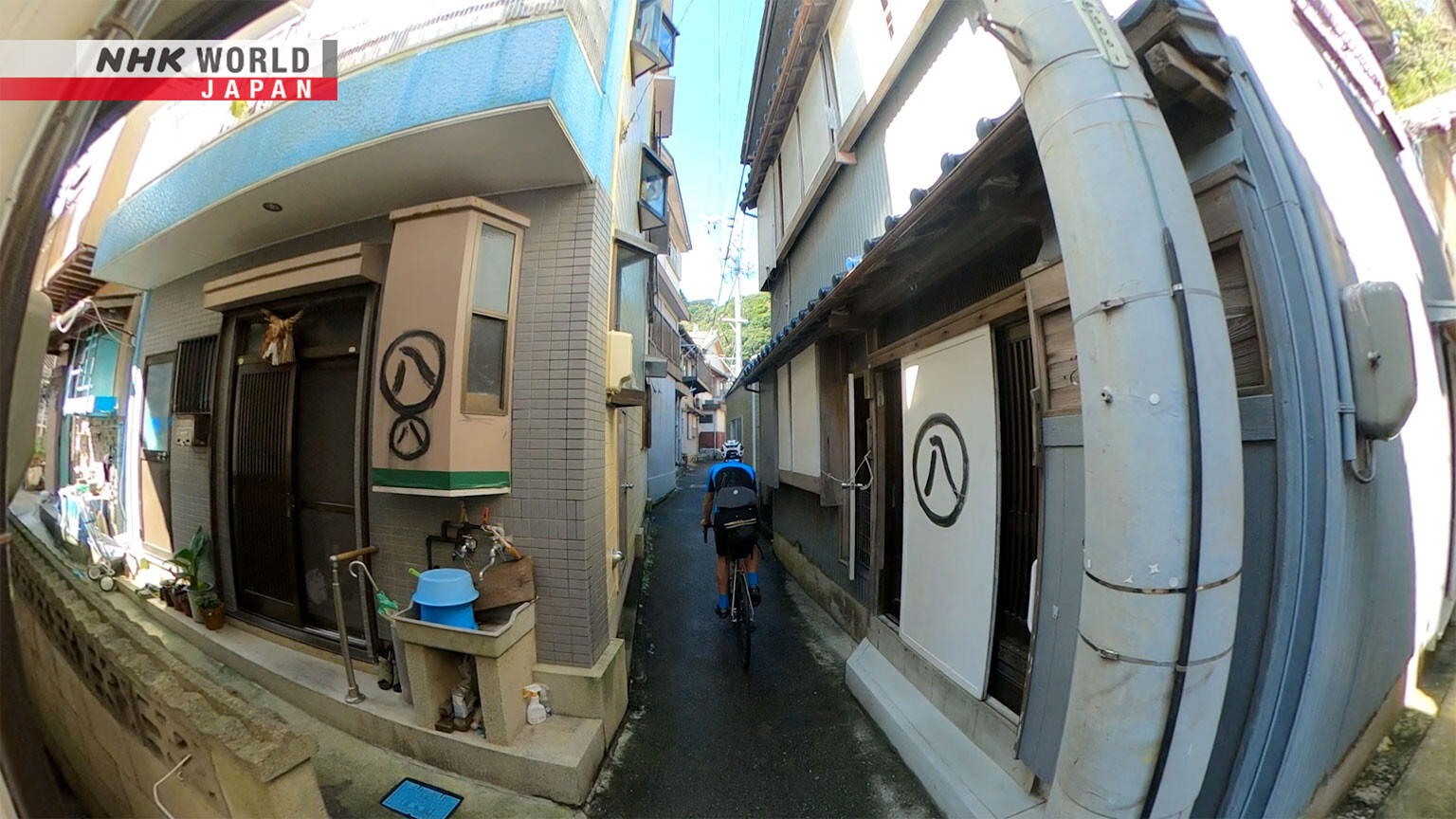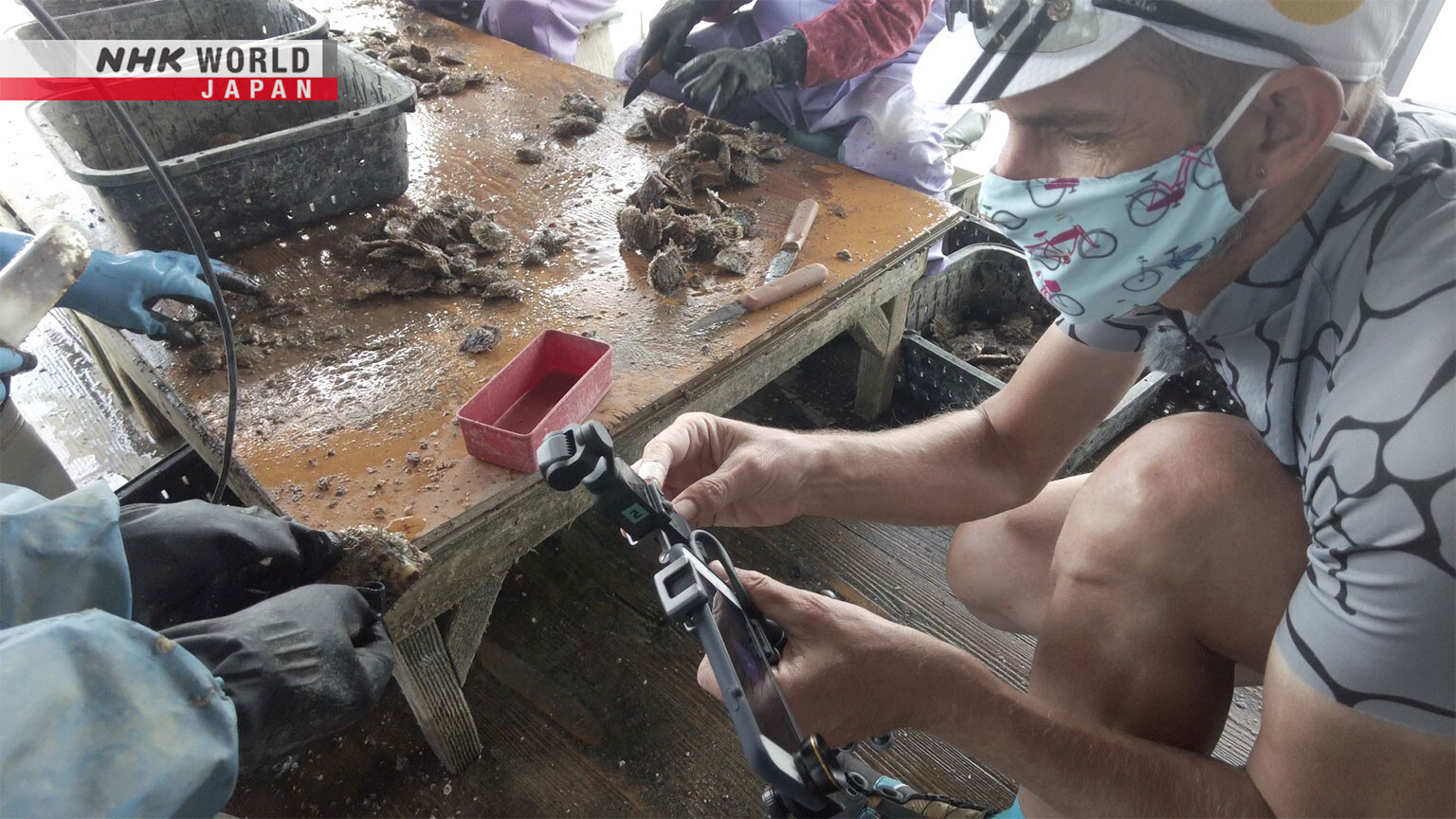Mie - A Cultural Crossroads
Zac Reynolds has lived in Japan for over 20 years, and now works for a bicycle maker in Mie Prefecture. As a crossroads on the old Tokaido Highway, Mie has a unique cultural legacy. In the post station of Sekijuku, we visit a sweets store run by the descendants of a famous ninja spy. After a small island fishing village where the locals preserve some unique customs, on the south coast we meet a couple who have cultivated pearls for 45 years. This remains one of Japan's most vibrant and exciting places to live.



Transcript
The best way to discover little-known sights and make even familiar places feel brand new, is to go exploring by bicycle.
This will be another of our "selfie rides,"
our idea for enjoying the "new normal," where our cyclists film themselves exploring areas close to home.
I did it!
We'll be riding around Mie.
A major crossroads throughout history, Mie shows how rich cultures develop from encounters with travelers from outside.
I love it when people tell us
our fans make the best breeze.
As well as encouraging the new, Mie treasures its old traditions.
We're an old island family, so I always felt
it was my duty to carry on cultivating pearls.
Ride with us in Mie, as we enjoy some fascinating encounters.
We start from the town of Kuwana.
Our cyclist, Zac Reynolds, came to Japan from Australia in 1998.
Zac was a well-known champion hill-climb racer when he was younger.
These days he mostly enjoys cycle touring.
Zac works for this bicycle manufacturer as their brand manager, responsible for planning, design and sales.
Okay, Cycle Around Japan viewers, this is where I work.
Zac's colleague Tezuka Yoshiko likes to bring her little dog Mame-chan to work.
He's like a Japanese - so serious about work.
Zac won't let anything slide. He always has to
get to the bottom of it and make it right.
This trip is one of our "selfie rides" - for safety during the pandemic, our cyclist also acts as cameraman.
He'll have one companion as support, his friend Asano Masanori, who's a cycling journalist.
Because Asano and Zac both like wearing blue gear, they call themselves the Blues Brothers.
Mie has always been an important crossroads where several major routes intersect,
including the famous Tokaido Highway linking Tokyo and Kyoto.
The first half of our trip follows the old highway, discovering how centuries of travelers gave rise to a unique culture.
We start from the point where the Tokaido enters Mie on its eastern border.
Okay, so let's go!
- Hello!
- You're on the Tokaido!
Right!
Some lovely ladies out for a chat.
On his cycle trips, Zac always enjoys looking out for historical spots connected with the old highway.
There's something on the corner here.
Let's stop and have a look at this.
There's a couple of memorial stones here.
And a couple of big rocks.
It says "chikara-ishi," so a rock of strength.
Originally collected for building temples, such stones were popular with young men wanting to show off their muscles.
It looks like there's some inscription in here.
This is 3, 10, and 2 to tell you how heavy it is.
So 32 kan, which is about 120kg.
Okay, you ready?
No, maybe I should try the kids one.
I did it!
We're now in the Hinaga district of Yokkaichi.
This is it. This gift shop here.
Inato.
Here we are.
Zac's been looking for a certain handicraft, and he thinks this store is the place for it.
Hello!
Inagaki Yoshihide is the fourth of his family to run this business.
This is amazing.
Look at all these fans.
Hinaga Uchiwa fans have a history going back 300 years.
They were such a popular souvenir for travelers on the old highway that Hinaga used to have 20 fan shops.
Now only this one remains.
These fans are so flexible, moving your
wrist slightly creates a strong breeze.
- May I try?
- Of course.
It's really light because it's made from natural materials, this kind of bamboo.
The handle feels really good too, much better than plastic.
The breeze feels really good.
Inagaki's wife Kazumi is an uchiwa artisan.
She shows Zac the way they have always traditionally been made.
She splits a piece of bamboo into 55 thin sections which will form the frame for attaching the paper.
What makes these uchiwa special?
In the old days, these were only
for fanning other people.
You used a normal fan to cool yourself,
but a Hinaga uchiwa to fan others.
For example, to fan your baby,
or cool your guests.
So one of their roles is to connect with others.
Despite its cultural significance, in modern times demand for Hinaga Uchiwa declined,
and today the Inagaki workshop is the only one still making them.
If we stopped making them, it would be the
end of a 300-year tradition.
You were the only ones left.
We couldn't let it die out.
Many times I've thought how much easier
my life would be if I gave it up.
But just at those moments a customer would
always tell me how much they loved our fans.
Hearing that, I couldn't quit.
A family striving to keep their treasured legacy alive.
Zac is now heading towards Sekijuku.
This town was once a famous post station on the old highway.
But first, he must tackle an obstacle dreaded by centuries of travelers.
A leg-breaker coming up.
Tsuetsuki Hill gets its name because it was impossible to climb without a "tsue" or walking stick.
- Good morning!
- Good morning!
Quite a hill, isn't it?
Phew. That was a good little leg opener for the morning.
We're now in Sekijuku.
These old houses date back over 200 years, and are mostly still used as family homes.
You can see a lot of signs that this place is still very much alive.
A greengrocer here.
Here's a bike shop.
There's a lot of shops catering to locals.
This is it.
Okay, so let's go.
- Good morning!
- Hi! Come in.
This cafe has a unique approach.
You make your coffee yourself, the way you prefer it.
Good coffee.
So I think this is the first self-pour coffee that I've ever tried.
Unusually for a coffee shop, they also serve traditional Japanese sweets.
Zac gets a Sekijuku specialty - a soft rice cake stuffed with azuki bean paste.
Here we go.
That's delicious!
The cafe is owned by this 380-year old confectionary shop.
Its 14th-generation owner, Hattori Kichiemon Aki, tells Zac about his store's unusual origins.
Hattori's ancestors were actually ninjas.
The family records contain many descriptions of their daring exploits.
The Iga ninja ran a sweet shop
as cover to hide their spying activities.
Delivering sweets to the imperial court
let them gather information for the shogun.
Those are the roots of our business.
This fancy box for sweets would be carried
inside the larger box for delivery to the palace.
As official suppliers, these spies could infiltrate the court and noble houses to gain access to political secrets.
The age of the ninja has long passed.
As the owner of the oldest family store in Sekijuku, Hattori is one of the town's civic leaders.
My family has always lived here and my dream is
to develop both our business and the town.
I hope there'll always be close links between
Seki-no-to and our shop.
You know, that coffee shop you were in was
also probably a place where spies operated.
I can imagine it.
Our cycling buddies have now ridden about 50 kilometers through Mie on the Tokaido.
Zac is now going deep into a part of Mie he doesn't know, a coastal area that promises new adventures.
Good morning, everyone.
As you can see, I'm on a boat today.
He's arrived at Toshijima, a small island with a population of about 1,600.
Thank you!
This looks like the Information Center.
Good morning!
Hello!
- I want to cycle around the area.
- You're cycling?
Where do you recommend I go?
This area of narrow lanes is interesting.
Too narrow for cars, but cycling will be fine.
There's another thing to look for.
- The old ladies have fancy carts they call "Jinjiro."
- "Jinjiro?"
You'll see them pushing them.
- You've been very helpful.
- Take care!
Wondering what he's going to find, Zac sets off to explore the island.
Excuse me! Coming through!
Hello!
It's getting pretty narrow here.
I don't see any cars in here, but a few motorbikes.
It would be hard to get in and out of here.
This one looks like we can get through somewhere.
Since ancient times, Toshijima has had a thriving fishing industry.
Space was always very tight on the island so they made the lanes this narrow in order to fit in enough houses for everyone.
Everybody has their "maruha" marks.
Of course, they're all handwritten.
They're all different.
"Maru" means circle in Japanese, and the central character is "hachi" or eight - hence "maruhachi."
Hello!
What do the signs on all the houses mean?
In our local Hachiman Shrine's big festival,
we carry charcoal around the streets.
People grab it to write these marks
on their houses and boats as a charm.
At this annual festival, they parade charcoal-spattered papers blessed by the shrine.
The villagers scramble for the paper and use it to paint "maruhachi" marks on walls as prayers for good fishing and safety.
So, the "hachi" part of "maruhachi" refers to the Hachiman Shrine.
- Hello! Nice day for just sitting in the sun.
- Hello!
- Do you all live around here?
- My house is just down there.
This is a nice place.
- Toshijima Island has good air.
- Good air?
Great.
I was told to ask about Jinjiro.
I think there's one over there.
A kindly local offers to help.
Ah, here we are!
That's a Jinjiro!
That metal cart?
Yes.
Interesting.
The mysterious jinjiro turn out to be carts fitted with a metal cage.
They were designed over 70 years ago by an island blacksmith called Jinjiro.
In a place with lanes too narrow for cars, jinjiro are used to transport almost everything.
Even though I've been here in Japan for over twenty years, there's always something new to discover.
A tiny island, but one with its own distinctive culture.
The last place Zac will visit is the Shima Peninsula.
The winding road along this jagged coastline makes for a great ride.
Wow, look at this view.
Wow, just looking straight out into the Pacific Ocean.
Awesome.
Coming into view now is Ago Bay.
With a generally mild climate and gentle seas, this became one of Japan's leading pearl cultivation areas.
Coming to greet Zac is Inoue Hisami.
She and her husband run a pearl cultivation business.
Hikaru, her husband, brings out some pearls to show Zac.
The best pearls are the ones used for rings.
And this is the best of all. Look how it gleams.
What makes a good pearl?
Round, even colors, good radiance.
But only 10 to 20% meet those standards.
The Inoues have about 100,000 oysters under cultivation.
It takes an oyster at least three years to produce a pearl.
Changes in water quality and temperature that shock and stimulate the oysters' growth are required to produce beautiful pearls.
- People don't develop without challenges, either.
- It's a fact.
I feel every new discovery makes me a bigger person.
If you were a pearl, you'd be a really big one.
I hope you're right.
Of their 100,000 oysters, less than half will produce a pearl.
And some years, they can lose them all to unpredictable diseases.
Many growers here have given up, but Inoue keeps on going.
It's been over 40 years now.
What kept you doing this all these years?
Well, nature isn't just going to give me
the results I want. It's up to me.
I'll soon have been trying for 45 years,
and I'm still not satisfied.
It feels like it was my destiny to come here.
Producing pearls has become my mission in life.
Sometimes I really feel that I am part of nature,
that nature is bringing me alive.
I plan to keep doing it until I die,
taking on fresh challenges every year.
There's one last sight to see - the famous sunset over Ago Bay.
Here we are.
Wow, look at that.
Beautiful.
What a perfect finish to this trip.
A sweeping view over Mie's island studded coast.
This was a really enjoyable trip.
All the people I met seemed really connected to the places where they live,
from the people on the Tokaido who'd been there for generations, all the folks on the island.
I think the real treasure of what I saw of Mie this time is the people,
and seeing the feeling that they have and the connection that they have with their surroundings and their community.
It's not the places you go to see, it's the meetings you have there and the people you meet,
and how you interact with those people that really makes a trip worthwhile.
A land shaped by encounters and connections.
And it's the promise of such encounters that keeps Zac cycling around Mie.